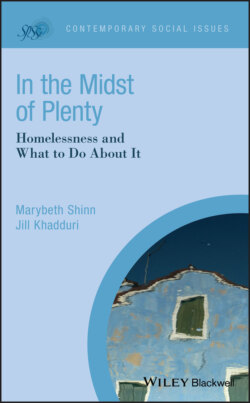Читать книгу In the Midst of Plenty - Marybeth Shinn - Страница 18
Youth
ОглавлениеThe federal government's 2010 strategic plan to end homelessness (U.S. Interagency Council on Homelessness, 2010) established separate goals for youth, and HUD began to track additional categories: unaccompanied children under the age of 18, youth aged 18–25 not accompanied by parents or their own children (also included in the counts of individuals); and parenting youth under 25 who have children with them but are not accompanied by anyone over 25 (also included in the counts of families if the parent is at least 18). The 2018 national point‐in‐time counts found around 36,000 unaccompanied children and youth and 8,700 parenting youth. Parenting youth are almost all 18–25 rather than younger than 18, and they make up about 15% of all family households (Henry, Mahathey, et al., 2018).12
Among the unaccompanied young people (sheltered and unsheltered), only 11% were children under the age of 18 (4,000 compared to 107,000 children experiencing homelessness in the company of adults (Henry, Mahathey, et al., 2018, pp. 1–3). Overwhelmingly, minor children who experience the literal homelessness reported by HUD do so as part of families.
However, researchers who focus on adolescent homelessness describe the way in which unaccompanied youth experience homelessness as different in kind from that of older adults or of children who are part of families. Instead of sleeping outdoors or going to shelters, young people who have run away or been thrown out by their families often “couch surf” with friends or are in makeshift and, all too often unsafe or exploitative arrangements (Family and Youth Services Bureau, n.d.; Morton, Dworsky, & Samuels, 2017).
Programs that are funded by the U.S. Department of Health and Human Services to serve homeless youth use a definition of homelessness that is broader than the eligibility criteria for HUD programs. The Runaway and Homeless Youth Act (RHYA) counts as homeless anyone up to age 21 “for whom it is not possible to live in a safe environment with a relative and who have no other safe alternative living situation” (U.S. Department of Health and Human Services, 2016a). Claims that adolescence is the age at highest risk of homelessness usually count young people, including young adults, who meet one of these expanded definitions and also count young parents in families. Some of these young parents were formerly unaccompanied youth who became pregnant or bore children while homeless (Toro, Dworsky, & Fowler, 2007) whereas others became homeless only after becoming pregnant or having a child.
HUD's estimates of numbers of youth experiencing unaccompanied homelessness are almost certainly undercounts, both because youth may use programs other than the shelters included in the administrative data reported by communities and because unsheltered youth may be even more likely than adults to avoid being found by street counts. HUD's estimates also do not include couch‐surfing or staying in exploitative situations—for example, as a victim of trafficking (Family and Youth Services Bureau, n.d.). In the Voices of Youth Count, a nationally representative sample of households, 12.5% of households with an 18–25‐year‐old member reported that at least one such member had experienced homelessness (self‐defined) or couch surfing without stable housing in the past 12 months. Follow‐up interviews with a small sample of individual youth themselves yielded a rate (including couch surfing) of 9.7% (Morton et al., 2017).
The Voices of Youth Count national survey also found that 4.3% of households with children 13–17 had a child who had run away, left home because of being asked to leave, couch surfed, or been homeless, although it is not clear that all these children were homeless on their own (Morton et al., 2017). The reasons that children leave home, including family conflict over sexual orientation, step‐parent relationships, and children's behavior (Toro, Dworsky, et al., 2007), are largely different than the reasons that adults become homeless, and the solutions are also quite different. What it takes to resolve homelessness for 13‐year‐olds who have run away or been forced to leave home are quite different from what from what it takes for 18‐year‐olds who are capable of living on their own and holding a lease. In subsequent chapters, we do not consider causes of homelessness or solutions for minor children who become homeless on their own. Young adults (“youth”) 18 and over are included—but typically not broken out—in many of the studies we cite later. Some studies concern special populations of young adults, such as youth aging out of the foster care system. As of this writing, evidence on the effectiveness of special programs for young adults is scarce.
